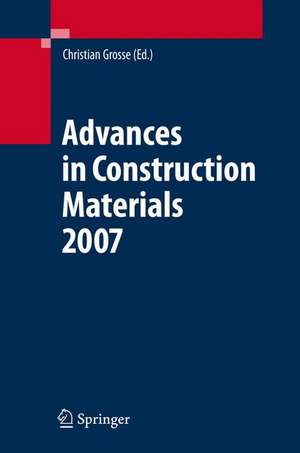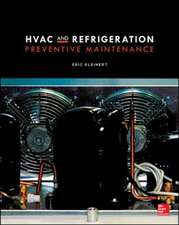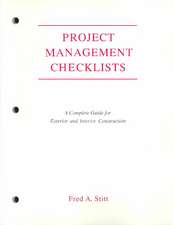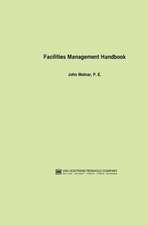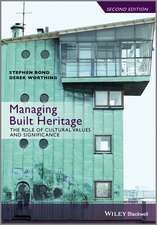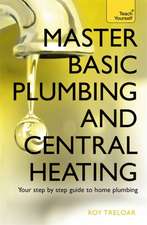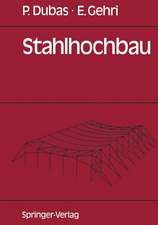Advances in Construction Materials 2007
Editat de Christian U. Grosseen Limba Engleză Hardback – 19 iul 2007
| Toate formatele și edițiile | Preț | Express |
|---|---|---|
| Paperback (1) | 1240.47 lei 43-57 zile | |
| Springer Berlin, Heidelberg – 14 oct 2010 | 1240.47 lei 43-57 zile | |
| Hardback (1) | 1254.68 lei 43-57 zile | |
| Springer Berlin, Heidelberg – 19 iul 2007 | 1254.68 lei 43-57 zile |
Preț: 1254.68 lei
Preț vechi: 1530.09 lei
-18% Nou
Puncte Express: 1882
Preț estimativ în valută:
240.16€ • 260.95$ • 201.86£
240.16€ • 260.95$ • 201.86£
Carte tipărită la comandă
Livrare economică 21 aprilie-05 mai
Preluare comenzi: 021 569.72.76
Specificații
ISBN-13: 9783540724476
ISBN-10: 3540724478
Pagini: 800
Ilustrații: XIV, 784 p.
Dimensiuni: 155 x 235 x 37 mm
Greutate: 1.51 kg
Ediția:2007
Editura: Springer Berlin, Heidelberg
Colecția Springer
Locul publicării:Berlin, Heidelberg, Germany
ISBN-10: 3540724478
Pagini: 800
Ilustrații: XIV, 784 p.
Dimensiuni: 155 x 235 x 37 mm
Greutate: 1.51 kg
Ediția:2007
Editura: Springer Berlin, Heidelberg
Colecția Springer
Locul publicării:Berlin, Heidelberg, Germany
Public țintă
ResearchDescriere
This book addresses one of the most important material categories: Materials used for constructions. A large percentage of the gross national product of most co- tries goes into infrastructure and buildings. This statement is true not only for the present but for most other periods in history, and for most cultures. This explains why understanding the behavior of construction materials has always been the - ject of intense investigations. The construction industry consumes extreme v- umes of material, and the growing demand for quality and safety require conti- ous improvement of materials and material compositions. A deep understanding of material behavior is essential to enable efficient construction: light-weight or heavily burdened structures ask for the development of innovative composites or new material compositions. Rapid economic growth and a dense and growing population require sensitive and sustainable use of resources. Finally efficient use of resources means extending the usage of existing structures, so non-destructive testing methods are needed to assess the safety and utility of these structures. Civil Engineers and Material Scientists from all over the world are openly d- cussing ideas for new materials, and for structural health monitoring. Over the last decade many innovations have come to fruition, primarily in the field of comp- ites but also for improving the design of existing material. This is especially true for concrete, perhaps the most used material in the world – broadening its range of applications and improving performance.
Cuprins
Brief Review of the Scientific Work of Prof. Dr.-Ing. Hans W. Reinhardt.- Brief Review of the Scientific Work of Prof. Dr.-Ing. Hans W. Reinhardt.- Towards a better visibility of outstanding research.- Towards a better visibility of outstanding research.- Aspects of Structural Engineering.- Actual tendencies in structural fastening technology.- Constitutive Laws for Concrete and their Application with Numerical Methods.- Innovations in concrete technology: Interaction between research, codes and applications.- Ultra-high performance concrete for the roof of a research hot water storage.- Numerical modelling of cam-pocket coupling systems for concrete lining.- Uncertainty models for safety assessment of textile reinforced concrete structures.- Structural design of a large foundation slab close to reality, stiffness oriented design method CTD.- Steel castings in architecture and engineering.- Load-bearing and deformation behaviour of concrete beams reinforced in combination of both steel bars and bars made of glass fibre reinforced plastic (GFRP).- Fiber Composites.- Mechanical and Fracture Mechanical Properties of Fine Grained Concrete for TRC Structures.- Enriched finite element representation of 2D multi-cracking and debonding in textile reinforced concrete.- Fracture properties of high-strength hybrid fiber-reinforced concrete.- Textile Reinforced Concrete — A new Composite Material.- Viscoelastic behavior of a strain hardening Ultra High Performance Fiber Reinforced Concrete.- Ductility and Fatigue Behaviour of Polymer-Modified and Fibre-Reinforced High-Performance Concrete.- Bond Cracking and Tension Stiffening Properties of a Deformed Bar Embedded in HPFRCC.- Tensile strain-hardening FRC composites: Historical evolution since the 1960.- UHPFRC protection layer on the crash barrier walls of a bridge.- Scale effect and combined loading of thin UHPFRC members.- Hybrid fibre concrete: is there a synergetic effect?.- Ultra high performance fibre reinforced cement composite under dynamic loading.- An Experimental Study on Bending Behavior of Cementitious Composites Reinforced in Combination with Carbon Textile and Short-Cut PVA Fiber.- Repair Materials and Strengthening Methods.- Performance of concrete patch repair systems.- Repair of cracked reinforced concrete by injection after accidental loading.- Seismic strengthening of piers with partial use of high ductility cement.- Sprayed GFRP shear-strengthened reinforced concrete Beams under Impact Loading.- High Temperature and Fire Resistance.- High Strength Fiber Composites for fabricating fire-resistant wood with improved mechanical properties.- Mechanical properties of SFRC at high temperatures.- Modifications of material properties due to elevated temperatures.- Corrosion and Durability.- Influence of cyclic loading on the degradation of mechanical concrete properties.- A material model for creep and fatigue applied to asphalt.- Simulation of the cyclic loading and damage behavior of gypsum composites.- Superabsorbent Polymers — An Additive to Increase the Freeze-Thaw Resistance of High Strength Concrete.- Corrosion products pressure needed to crack the concrete cover.- Failure mechanisms in fatigue of high strength steel wires for cable-constructions.- Durability aspects of AR-glass-reinforcement in textile reinforced concrete, Part 1: Material behaviour.- Durability aspects of AR-glass-reinforcement in textile reinforced concrete, Part 2: Modelling and exposure to outdoor weathering.- Stress corrosion cracking mechanism of prestressing steels in bicarbonate solutions.- Moisture Transport in Concrete — Field Tests and Hygrothermal Simulations.- Impact of Freeze-Thaw Degradation on FRP-Concrete Interface Fracture.- Effective chloride barrier for reinforced concrete structures in order to extend the service-life.- Properties, Modeling and Testing of Fresh Concrete.- Setting and hardening of cement based materials: which differences between mortars and concretes?.- Mechanical properties of cement mortars with superabsorbent polymers.- Formwork Pressure of Concretes with high Workability.- Modern statistical methods for accessing the hardening process of concrete.- Virtual concrete laboratory — Continuous numerical modelling of concrete from fresh to the hardened state.- Detection of early-age cracking due to restrained autogenous shrinkage.- Ultrasonic and calorimetric measurements on fresh concrete with blast-furnace slag.- Fresh concrete pressure in diaphragm wall panels and resulting deformations.- SCC and UHPC — Effect of Mixing Technology on Fresh Concrete Properties.- Analytical model for hydration of blended cement.- Nucleation and growth of C-S-H phases on mineral admixtures.- Improving the slipform process via material manipulation.- Non-destructive Testing Methods and Applications.- Sensing methods in civil engineering for an efficient construction management.- Fast Non-Destructive Localisation of Prestressing Steel Fractures in Post-Tensioned Concrete Bridges.- New Possibilities for Ultrasonic Imaging of Concrete Elements.- Quantitative Non-Destructive Testing: The integration of non-destructive testing and probabilistic fracture mechanics.- Advances in the in-situ assessment of construction materials.- Detection and analysis of microcracks in high-performance cementitious materials.- Acoustic Emission Techniques for Rebar Corrosion in Reinforced Concrete.- Online-Monitoring of Thermal Restraint Stresses for a Railways Trough Structure due to the Coupling of Trough and Underwater Concrete Slab.- Radar and Fusion for Concrete Elements.- Inspection of Prestressed Concrete Members using the Magnetic Leakage Flux Measurement Method — Estimation of Detection Limit.- Environment and Sustainability.- Abatement of Acid Mine Drainage Using Industrial Waste Products.- Finely Ground Sand Fraction of Concrete Rubble as a Supplementary Cementitious Material.- Numerical Simulation of Air-Steam Leakage Behaviour of Reinforced Concrete Walls.- Sustainable building with concrete — a holistic approach along the Life-Cycle.- Dangerous Substances in Building Materials — Emissions from PCB Coated Ceiling Panels — Polychlorinated Biphenyls (PCB) in Indoor Air.- Demountable concrete buildings, structural design of floor slabs with concrete elements and aluminium foam.- Reduction of the Penetration of Water-Hazardous Liquids into Concrete using Silica Fume and Polymer Dispersions.- Mechanical and Thermal Properties of Materials.- Tension Softening Curves Described by Algebraic Formulas and Artificial Neural Networks.- Effects of a clay additive on the properties of no-slump concrete.- Development of thermal insulation materials with granular phase change composite.- Examination of the relation between tensile/flexural strength and compressive strength of autoclaved aerated concrete according to prEN 12602.- Modern perspectives on aggregate in concrete.- Research developments and experimental data on dynamic concrete behaviour.
Notă biografică
PrivDoz Dr.-Ing. Christian U. Große, born 1961, studied Geophysics at the University of Karlsruhe (TH) and earned his Ph.D. in 1996 in Civil Engineering at the University of Stuttgart followed by his Habilitation in 2005 at the same place. He is University lecturer (Privatdozent) at the University of Stuttgart and head of the Department of "Non-destructive testing and monitoring techniques" at the Material Testing Institute MPA, University of Stuttgart. Currently, he has published more than 180 scientific papers at international journals and conferences. His research interest include the application and development of non-destructive testing methods (ultrasound, acoustic emission, impact-echo, vibration and modal analysis, Radar, optical methods) as well as structural health monitoring using wireless sensor networks.
Textul de pe ultima copertă
The book is a compilation of recent research results on building construction materials. The construction industry consumes extreme volumes of material, and the growing demand for quality and safety require continuous improvement of materials and material compositions. A deep understanding of material behavior is essential to enable efficient construction: light-weight or heavily burdened structures ask for the development of innovative composites or new material compositions.
Civil Engineers and Materials Scientists from all over the world present their ideas for further material developments, the testing of structures and solutions for in situ applications. Many of the innovations, composites and the design of existing material mixes, especially for concrete, are discussed. These include high-strength and high-performance concrete (HPC), self-compacting concrete (SCC), shotcrete, and textile or fiber reinforced concrete (FRC).
Moreover, the enhancement of material variations and the improvement of their properties are observed for most construction materials (e.g. wood, masonry, steel, polymers).
This book gives a good overview about the state-of-the-art in construction material science. Some of the world’s leading experts have contributed in honor of Professor Dr.-Ing. Hans W. Reinhardt. The book starts with a review about his scientific achievements up to his recent retirement. Some contributions are presented at the conference "Advances in Construction Materials" (ACM2007) held in July 2007 in Stuttgart.
Civil Engineers and Materials Scientists from all over the world present their ideas for further material developments, the testing of structures and solutions for in situ applications. Many of the innovations, composites and the design of existing material mixes, especially for concrete, are discussed. These include high-strength and high-performance concrete (HPC), self-compacting concrete (SCC), shotcrete, and textile or fiber reinforced concrete (FRC).
Moreover, the enhancement of material variations and the improvement of their properties are observed for most construction materials (e.g. wood, masonry, steel, polymers).
This book gives a good overview about the state-of-the-art in construction material science. Some of the world’s leading experts have contributed in honor of Professor Dr.-Ing. Hans W. Reinhardt. The book starts with a review about his scientific achievements up to his recent retirement. Some contributions are presented at the conference "Advances in Construction Materials" (ACM2007) held in July 2007 in Stuttgart.
Caracteristici
Gives an overview about the state of the art in construction materials
